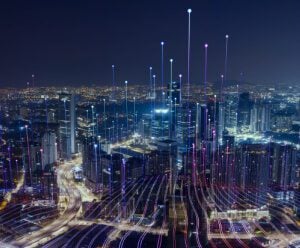
Softening U.S.-China trade delivers a win for Asia Pacific

Geopolitical tensions between the U.S. and China have prompted predictions of a new trade war that could fracture the global economy into rival blocs.
The United States’ (U.S.) goods trade deficit with China dropped by 27 percent to US$279 billion in 2023, the lowest level in more than 10 years. As well as reflecting reduced imports from China, this deficit decline raises critical questions about trade levels between the two economies, following the punitive tariffs imposed on Chinese imports in 2018.
However, as new research from DHL indicates, globalization is very much alive. The DHL Global Connectedness Report 2024 shows that international trade flows now span longer distances than before the Covid-19 pandemic and extend beyond major geographic regions, defying predictions of increased regionalization. This is largely thanks to the growth of emerging economies and the opportunities they create for further cross-regional exchange.
At the same time, trade connectivity continues to expand. DHL’s report found that global connectedness — measured by the depth and breadth of flows in trade, capital, information, and people — reached a record high in 2022 and remained close to that level in 2023.
“In short, rather than retreating from globalization, the world is undergoing a paradigm shift, with Asia Pacific poised to emerge as a key hub for trade growth,” said Ken Lee, CEO, DHL Express Asia Pacific.
Countries in the region are seizing this opportunity to expand and deepen their trading capabilities, strengthening their global connectedness. The fact that Singapore once again retains its position as the world’s most connected country in the Global Connectedness Report 2024 rankings, even after years at the top, is another indicator of globalization’s resilience.
Asia-Pacific markets rise
Amidst a softening in trade between the U.S. and China, Asia Pacific markets are stepping up to fill the gap. Vietnam, India, and Malaysia have emerged as key global trade players, attracting companies that are shifting their production away from China.
This is evident from the €350 million investment from DHL Supply Chain to expand its warehousing capacity, workforce and sustainability initiatives in Southeast Asia. The initiative will expand its current 1.6 million square meters of warehouse space in Southeast Asia by 25 percent, or 400,000 square meters, across facilities in West Java, Indonesia; Penang, Malaysia; the Philippines and Singapore. Moreover, it adds the potential to introduce more than 3,000 job opportunities across the four markets in 2024.
Even with China’s decreased share of U.S.-manufactured imports, a significant portion of increased imports from Vietnam and other key markets often comprise components originally sourced from China.
Even with China’s decreased share of U.S.-manufactured imports, a significant portion of increased imports from Vietnam and other key markets often comprise components originally sourced from China. Analysis shows that while China’s proportion of U.S.-manufactured imports declined from 2017 to 2020, China’s share of value added in goods consumed in the U.S. slightly rose. For example, U.S. imports of laptops from Vietnam surged alongside Vietnamese imports of laptop parts from China between 2017 and 2022.
Continued connectivity amidst changing dynamics
DHL’s data also reveals that flows across trade, capital, information, and people between the U.S. and China remain substantial. What we see today is a partial unwinding of the unusually high levels of U.S.-China integration that have existed over the past two decades. In fact, they maintain larger flows between them than any other pair of countries without a common border, except for the U.S. and the United Kingdom.
Despite the two nations’ vast geographic distance, as well as cultural and institutional differences, they still remain highly interconnected. DHL’s report shows that in These levels of collaboration exceed those seen in other parts of the world.
Driving global trade growth
With ongoing efforts to strategically de-risk supply chains, global flows also continue at healthy levels. The geographic diversification of production away from China may even boost trade – as other manufacturing hubs lack the domestic resources of the Chinese market, they must import materials from other countries.
Other Asia Pacific markets stand to benefit from this trend as the region’s trade growth accelerates, strengthening its position as a leading global economic powerhouse and trade hub. , and this year, it is forecast to be the fastest-growing region in terms of both export and import.
The recent DHL Express Central Asia Hub expansion underscores the importance of the region’s connectivity. The hub, which is by far the largest infrastructural investment by DHL Express with a total investment of €562 million, has almost 70 percent more handling capacity and 50 percent more warehouse space than before the expansion.
Some of Asia Pacific’s rapidly expanding economies are now crucial trade partners for the world. India, for example, ranks ninth in the Global Connectedness Report on breadth in global merchandise trade. With its status as the fastest-growing large economy, India’s international flows could outpace its domestic activity, placing the country in an increasingly central role in the future of globalization.
No market exemplifies this proactive policy stance more than Singapore. The city-state’s status as the world’s most globally connected nation in the Global Connectedness Report highlights the effectiveness of its policies in promoting trade and global connectivity. Its outperformance, particularly in trade and capital flows, underscores the significant role of public policy in driving connectedness.
As a leading hub in one of the world’s fastest-growing regions, Singapore’s proactive approach not only reinforces its position as a key player in global trade, but also sets a benchmark for other economies in Asia Pacific.
Embracing global shifts
Globalization remains resilient despite geopolitical tensions and the evolving global trade dynamics. Emerging economies, especially those in the Asia-Pacific region, are set to play an increasingly pivotal role in driving cross-regional exchange.
Maintaining collaboration and openness to cross-border trade will be more essential than ever for sustaining global growth and connectedness.
MORE FROM THIS COLLECTION












 English
English